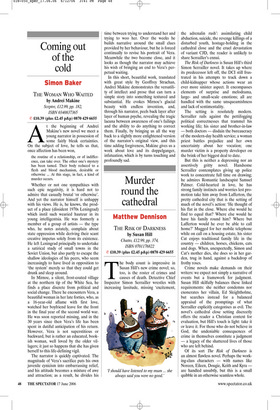Murder round the cathedral
Matthew Dennison
THE RISK OF DARKNESS by Susan Hill Chatto, £12.99, pp. 374, ISBN 0701176822 ✆ £10.39 (plus £2.45 p&p) 0870 429 6655 The body count is impressive in Susan Hill’s new crime novel; so, too, is the roster of crimes and causes of death. Detective Chief Inspector Simon Serrailler wrestles with increasing lassitude, missing ‘excitement, the adrenalin rush’: assimilating child abduction, suicide, the revenge killings of a disturbed youth, hostage-holding in the cathedral close and the cruel devastation of variant CJD, the reader is unlikely to share Serrailler’s ennui.
The Risk of Darkness is Susan Hill’s third Simon Serrailler novel. It takes up where its predecessor left off, the DCI still frustrated in his attempts to track down a child-kidnapper whose actions wear an ever more sinister aspect. It encompasses elements of surprise and melodrama, largeand small-scale emotions; all are handled with the same unsqueamishness and lack of sentimentality.
The setting is resolutely modern. Serrailler rails against the pettifogging political correctnesses that trammel his working life; his sister and brother-in-law — both doctors — disdain the bureaucracy of the modern-day health service; a woman priest battles prejudice and her own uncertainty about her vocation; one murder victim is a property developer on the brink of her biggest deal to date.
But this is neither a depressing nor an assertively gritty novel. Handsome Serrailler contemplates giving up police work to concentrate full time on drawing; he admires Romantic landscapist Samuel Palmer. Cold-hearted in love, he has strong family instincts and worries lest promotion take him away from Lafferton, the pretty cathedral city that is the setting of much of the novel’s action: ‘He thought of his flat in the close. Where else would he find to equal that? Where else would he have his family round him? Where but Lafferton would he ever be able to call home?’ Mugged for her mobile telephone while on call on a housing estate, his sister Cat enjoys traditional family life in the country — children, horses, chickens, cats and dogs. When, unexpectedly, Simon and Cat’s mother dies, she does so in her garden, trug in hand, against a backdrop of frothy roses.
Crime novels make demands on their writers: we expect not simply a narrative of events but a framework for judgment. Susan Hill skilfully balances these linked requirements: she neither condemns nor exonerates her villain, Ed Sleightholme, but searches instead for a balanced appraisal of the promptings of what Serrailler explicitly categorises as evil. The novel’s cathedral close setting discreetly offers the reader a Christian context for evaluation, but Hill’s touch is light: take it or leave it. For those who do not believe in God, the undeniable consequences of crime in themselves constitute a judgment — a legacy of the shattered lives of those who are left behind.
Of its sort The Risk of Darkness is an almost flawless novel. Perhaps the working-class characters — with names like Noreen, Eileen, Dougie, Keith and Kyra are handled unsubtly, but this is a small quibble in an otherwise seamless whole.


















































































 Previous page
Previous page